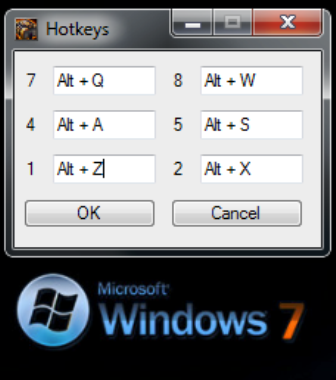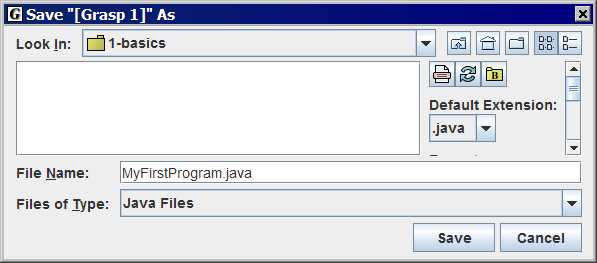

- #Jgrasp hotkeys pdf
- #Jgrasp hotkeys install
- #Jgrasp hotkeys zip file
- #Jgrasp hotkeys android
- #Jgrasp hotkeys software
To install the JDK, search the web for “download JDK” which should take you to Oracle’s website. The IDE we recommend is DrJava, which is an open-source development environment written in Java (see Figure A.1). The JDK we recommend is Java SE (Standard Edition), which Oracle makes available for free. A simple text editor such as Notepad++ or Sublime Text, and/or an IDE such as DrJava, Eclipse, jGrasp, or NetBeans.The Java Development Kit (JDK), which includes the compiler, the Java Virtual Machine (JVM) that interprets the compiled byte code, and other tools such as Javadoc.
#Jgrasp hotkeys software
If you are unable to install software on your computer (which is often the case in public schools and Internet cafés), you can use these online development environments for almost everything in this book.īut if you want to compile and run Java programs on your own computer, you will need: The easiest way to start programming in Java is to use a website that compiles and runs Java code in the browser.Įxamples include, ,, and others. Instead, we provide this appendix with a brief introduction to DrJava – an integrated development environment (IDE) that is well suited for beginners – and other development tools, including Checkstyle for code quality and JUnit for testing. We avoided putting these details in the main text, because they can be distracting. The steps for compiling, running, and debugging Java code depend on your development environment and operating system.
#Jgrasp hotkeys pdf
You might prefer to read the PDF version, or you can buy a hardcopy at In particular, some of the symbols are not rendered correctly. The development of previous versions of GRASP was supported by research grants from NASA Marshall Space Flight Center, the Department of Defense Advanced Research Projects Agency ( DARPA), and the Defense Information Systems Agency ( DISA).This HTML version of Think Java is provided for convenience, but it is not the best format of the book. The development of jGRASP has been supported by a research grant from the National Science Foundation. It is maintained and evaluated by the jGRASP Team. JGRASP was created by James Cross and Larry Barowski at the Department of Computer Science and Software Engineering in the Samuel Ginn College of Engineering at Auburn University. JGRASP also generates UML diagrams for Java, with interactive dependency information. The metric includes common measures, such as reachability and content complexity, which can be displayed individually. jGRASP generates CPGs for both Java and Ada. Its purpose is to aid in identifying overly complex areas of source code. The Complexity Profile Graph (CPG) is a statement-level complexity diagram. Multiple viewers can be combined on a single viewer canvas window and the contents can be saved to file. Other viewers show, for example, a color swatch for a Color, the image for an icon, and the binary details of a double. Common data structures are automatically identified and displayed structurally. The result is animated when changes occur, as when a node is added to a linked list.


Structural views of linked data structures display local variable nodes and their relation to the main structure. Structural views show the internal structure of trees, linked lists, hash tables, etc. For example, a content-based view shows ArrayList and LinkedList in an identical way, as a list of elements. The Java object viewers in jGRASP provide interface-based, structural, and other views of data structures and other objects and primitives during debugging and workbench operations. The editing window provides CSD-based folding and a "context hint" feature that displays the first line of a code structure that is off-screen when the mouse is hovered over its CSD structure. jGRASP produces CSDs for Java, C, C++, Objective-C, Ada, and VHDL. Its purpose is to improve the readability of source code. The Control Structure Diagram (CSD) is a control flow diagram that fits into the space normally taken by indentation in source code. It can be configured to work with most free and commercial compilers for any programming language.
#Jgrasp hotkeys zip file
The jGRASP web site offers downloads for Windows, Mac OS, and as a generic ZIP file suitable for Linux and other systems.įor languages other than Java, jGRASP is a source code editor. GRASP (Linux, UNIX) and pcGRASP (Windows) are written in C/C++, whereas jGRASP is written in Java (the "j" in jGRASP means it runs on the JVM). JGRASP is implemented in Java, and runs on all platforms with a Java Virtual Machine (Java version 1.8 or higher).
#Jgrasp hotkeys android
The runtime data structure visualizations are also available as plugins for IntelliJ IDEA, Android Studio, and Eclipse. It produces static visualizations of source code structure and visualizations of data structures at runtime. JGRASP is a development environment that includes the automatic creation of software visualizations.


 0 kommentar(er)
0 kommentar(er)
